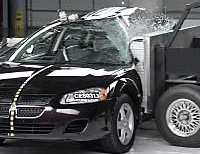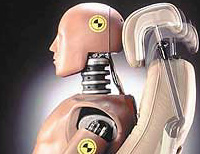|

Crash Test Results and Side Impact Ratings
Most
small car designs earned poor ratings in side impact crash
tests recently conducted by the Insurance Institute for
Highway Safety. Only the Chevrolet Cobalt and Toyota Corolla,
both equipped with optional side airbags with head protection,
performed well enough to earn the Institute's second highest
rating of acceptable. Without the optional airbags, the
Cobalt and Corolla are rated poor for side impact protection.
The test represents what happens when a passenger vehicle
is struck in the side by a pickup truck or SUV.
Another
12 small cars also earned poor ratings: Dodge Neon, Ford
Focus, Hyundai Elantra, Kia Spectra, Mazda 3, Mitsubishi
Lancer, Nissan Sentra, Saturn ION (tested with and without
side airbags), Suzuki Forenza, Suzuki Aerio, and Volkswagen
New Beetle.
Three
more small cars will be tested in side impacts later this
year. The Mini Cooper and Subaru Impreza will have new
design features that are intended to improve side impact
protection. The Honda Civic will be a completely redesigned
model.
"These
side impact results are similar to the results in 1997
when the Institute first rated small cars in the frontal
offset crash test," says Institute chief operating
officer Adrian Lund. "Back then, no small car earned
a good frontal crash test rating. Now almost every small
car earns a good rating in the frontal test. As manufacturers
redesign their vehicles, we expect that small cars will
get better in the side impact test too."
 |
A
moving deformable barrier strikes the driver side
of a passenger vehicle at 31 mph. The barrier weighs
3,300 pounds and has a front end that is shaped
to simulate the front end of a typical pickup or
SUV. |
In
the Institute's side impact test, a moving deformable barrier
strikes the driver side of a passenger vehicle at 31 mph.
The barrier weighs 3,300 pounds and has a front end that
is shaped to simulate the front end of a typical pickup
or SUV. In each side-struck vehicle are two instrumented
dummies the size of a small (5th percentile) woman, one
positioned in the driver seat and one in the rear seat behind
the driver.
New
frontal test results: The Institute also conducted
frontal offset crash tests of the Cobalt and Spectra. The
Cobalt was tested because it's a new design. Kia requested
the test of the Spectra after modifying the design of the
airbag system. Before this change, the Spectra was rated
poor in the frontal test.
In the frontal offset test, the vehicle strikes a deformable
barrier at 40 mph. The vehicle is offset, so only 40 percent
of the front end strikes the barrier on the driver side.
In offset tests a smaller area of the front end must manage
the crash energy, compared with full-width tests. Injury
measures are taken from a dummy representing an average-size
male (50th percentile) positioned in the driver seat.
Cobalt
and Corolla are acceptable with side airbags:
Side curtain-style airbags designed to protect the heads
of front- and rear-seat occupants are optional on these
vehicles (front seat-mounted torso airbags are included
with the airbag option on the Corolla). When side airbags
are optional, the Institute tests without the option and
will conduct a second test with the optional airbags if
the manufacturer requests it and reimburses the Institute
for the cost of the vehicle. General Motors requested second
tests of the Cobalt and Saturn ION. Toyota requested a second
test of the Corolla.
"With
the curtain airbags the heads of the dummies in the front
and rear seats of the Cobalt and Corolla were cushioned,
and head injury measures were low," says Lund. "Head
injuries are a factor in many deaths in real-world side
impact crashes, and side airbags designed to protect the
head make a big difference."
In the Cobalt, forces on the driver dummy's torso indicated
the possibility of rib fractures or internal organ injuries.
In the Corolla, there was the possibility of a fractured
pelvis. Protection for the rear passenger was good in
both cars.
"GM
and Toyota still need to beef up the side structures to
improve their side impact ratings from acceptable to good," says Lund.
In the Institute's frontal offset test, the Cobalt and
Corolla are rated good and "best picks." The
Cobalt's seat/head restraints are rated good based on
a test that simulates a rear impact, and the Corolla's
are poor. Taken together with ratings in the side impact
test, the Cobalt and Corolla equipped with optional side
airbags now are the highest rated small cars overall in
the Institute's crashworthiness ratings.
 |
The
test represents what happens when a Neon is struck
in the side by a pickup truck or SUV. |
Neon
is worst performer: The Neon has "major
problems beginning with its structure. This car is a disaster,"
Lund says. "The structure is poor, and both dummies'
heads were hit by the barrier during the crash test. High
forces were recorded on the head, torso, and pelvis of the
driver dummy. If this had been a real driver in a real crash,
it's likely it wouldn't have been survivable."
While
combination head and torso side airbags for the front
occupants are available on the Neon, DaimlerChrysler did
not ask for a second test with the airbags.
"With
a poor structure, the company probably didn't think side
airbags would make a big difference in the Neon's performance,"
Lund says. Pointing to the Neon's marginal rating in the
Institute's frontal test, he adds, "if safety is
a priority, the Neon is a small car to be avoided."
Vehicles
need good structure as well as side airbags:
Four of the vehicles that earned poor side crashworthiness
ratings (Elantra, Forenza, New Beetle, and Spectra) are
equipped with standard side airbags with head protection.
These cars are rated good or acceptable for head injury
measures recorded on the driver dummies. The Saturn ION
with optional side airbags also earned an acceptable rating
for driver head injury. However, the structures of all of
these vehicles allowed too much intrusion during the test.
Forces recorded on the driver dummies' torsos and/or pelvic
areas were high.
"Side
airbags can protect the head, but if the vehicle structure
doesn't hold up well then serious injuries to other body
regions still can occur," Lund points out. "With
better structures along with the side airbags, the performances
of these vehicles would improve."
Side airbags are reducing risks in real-world crashes:
Institute research shows that side airbags with head protection
are reducing deaths by about 45 percent among drivers
of cars struck on the driver side. Before the availability
of head-protecting airbags, there was virtually nothing
to prevent people's heads from being struck by intruding
vehicles or rigid objects like trees or poles in serious
side impacts. Side airbags that protect the chest and
abdomen, but not the head, also are reducing deaths but
are less effective (about a 10 percent reduction in deaths).
Plus well-designed doors with appropriate padding can
provide good protection for the chest and abdomen.
Head-protecting
airbags are necessary for effective side impact protection,
but torso airbags are not. For example, the Corolla the
Institute tested was equipped with torso airbags. The
Cobalt wasn't. Both had head-protecting curtain airbags.
Both earned acceptable ratings.
Cobalt
is 'best pick' in frontal test: This is General
Motors' new entry in the small car category. It's a big
improvement over the Chevrolet Cavalier, which still is
being sold. The Cavalier is rated poor for frontal crashworthiness.
"The
Cobalt's structure held together very well in the frontal
test," Lund says. The driver's survival space was
maintained, and there was minimal to moderate intrusion
into the foot well area. The dummy's movement was well
controlled during the crash, and all injury measures were
low. The Cobalt is rated good and earned the added designation
of "best pick."
Spectra's
frontal crash performance improves: When the
Institute tested the Kia Spectra last year; it was the first
vehicle since 2001 to earn a poor rating in the frontal
test. Among other factors, forces on the dummy's head were
high when it bottomed out the airbag and then struck the
door frame. Kia redesigned the driver airbag and asked the
Institute to test the Spectra again.
"In
this new test, the Spectra's performance was better but
not improved enough to earn a good rating," Lund
points out. "Another high head acceleration occurred
when the dummy's head bottomed out the airbag but, overall,
injury measures were lower, dummy movement was somewhat
better controlled, and the Spectra moves from a poor rating
to acceptable" (the improved rating applies to Spectras
built after January 2005).
 |
Vehicles
are Evaluated by injury measures recorded on two
instrumented SID-IIs dummies. |
How
vehicles are evaluated in the side impact test:
Each vehicle's overall side evaluation is based on injury
measures recorded on two instrumented SID-IIs dummies, assessment
of head protection countermeasures, and the vehicle's structural
performance during the impact. Injury measures obtained
from the two dummies, one in the driver seat and the other
in the rear seat behind the driver, are used to determine
the likelihood that the driver and/or passenger would have
sustained serious injury to various body regions. The movements
and contacts of the dummies' heads during the crash also
are evaluated. This assessment is more important for seating
positions without head-protecting airbags which, assuming
they perform as intended, should prevent injurious head
contacts.
Structural
performance is based on measurements indicating the amount
of B-pillar intrusion into the occupant compartment. Some
intrusion into the compartment is inevitable in serious
side impacts, but any intrusion that does occur should
be uniform both horizontally and vertically and shouldn't
seriously compromise the driver or passenger space.
Institute's
frontal test complements government test: Each
vehicle's overall frontal evaluation is based on results
of a 40 mph frontal offset test into a deformable barrier.
The evaluation is based on three aspects of performance
- measurements of intrusion into the occupant compartment,
injury measures from a Hybrid III dummy positioned in the
driver seat, and analysis of slow-motion film to assess
how well the restraint system controlled dummy movement
during the test.
The
federal government has been testing new passenger vehicles
in 35 mph full front crash tests since 1978. This New
Car Assessment Program has been a major contributor to
crashworthiness improvements, in particular improved restraint
systems in new passenger vehicles. The Institute's offset
tests, conducted since 1995, involve 40 percent of a vehicle's
front end hitting a deformable barrier at 40 mph. This
test complements the federal test involving the full width
of the front end hitting a rigid barrier. Both tests are
contributing to improvements in crashworthiness, in particular
improved crumple zones and safety cages.
The
same 40 mph offset crash test is used to evaluate new
cars by the European Union in cooperation with motor clubs,
by an Australian consortium of state governments and motor
clubs, and by a government-affiliated organization in
Japan.
(Source: Insurance
Institute of Highway Safety) |